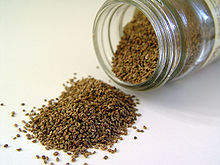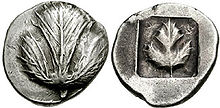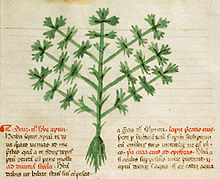NIMI:
Apium graveolensis (laji) var. dulce (muunnos)
APIACEAE,
APIUM selleirt. Celery.Stjälksellery
https://en.wikipedia.org/wiki/Celery
CeleryNandu (Apium graveolens) is a cultivated plant, variety in the family Apiaceae, commonly used as a vegetable. Depending on location and cultivar, either its stalks or its hypocotyl are eaten and used in cooking.
In North America the dominant variety most commonly available in trade is "celery", Apium graveolens var. dulce, whose stalks are eaten raw, or as an ingredient in salads, or as a flavoring in soups, stews, and pot roasts.
In Europe the dominant variety most commonly available in trade is celeriac (Apium graveolens var. rapaceum) whose hypocotyl forms a large bulb which is eaten raw grated in a salad, cooked, or as the major ingredient in a soup. It is commonly, but incorrectly, called "celery root". The leaves of rapaceum are used as seasoning, but its fibrous stalks find only marginal use.[2][3][4]
Celery seed is also used as a spice. its extracts are also used in medicines. The plant grows to 1 m (3.3 ft) tall.
Celery leaves are pinnate to bipinnate with rhombic leaflets 3–6 cm (1.2–2.4 in) long and 2–4 cm broad. The flowers are creamy-white, 2–3 mm in diameter, and are produced in dense compound umbels. The seeds are broad ovoid to globose, 1.5–2 mm long and wide. Modern cultivars have been selected for solid petioles, leaf stalks.[5] A celery stalk readily separates into "strings" which are bundles of angular collenchyma cells exterior to the vascular bundles.[6]
Taxonomy
Cross-section of a 'Pascal' celery rib, the petiole
Etymology
First attested in English in 1664, the word "celery" derives from the French céleri, in turn from Italian seleri, the plural of selero, which comes from Late Latin selinon,[7] the latinisation of the Greek σέλινον (selinon), "parsley".[8][9] The earliest attested form of the word is the Mycenaean Greek se-ri-no, written in Linear B syllabic scripCultivation
Head of celery, sold as a vegetable. Usually only the leaf stalks are eaten
In the past, celery was grown as a vegetable for winter and early spring; it was perceived as a cleansing tonic, welcomed to counter the salt-sickness[further explanation needed] of a winter diet. By the 19th century, the season for celery had been extended, to last from the beginning of September to late in April.[12]
North America
In North America, commercial production of celery is dominated by the cultivar called 'Pascal' celery.[5] Gardeners can grow a range of cultivars, many of which differ from the wild species, mainly in having stouter leaf stems. They are ranged under two classes, white and red. The stalks grow in tight, straight, parallel bunches, and are typically marketed fresh that way, without roots and just a little green leaf remaining.Europe
In Europe the dominant variety of celery most commonly grown is Apium graveolens var. rapaceum grown because its hypocotyl forms a large bulb, correctly called celeriac, but often incorrectly called celery root. The leaves are used as seasoning, and the stalks find only marginal use.[2][3][4]Asia
Chinese celery (Apium graveolens var. secalinum) is a cultivar from East Asia.Wild
The wild form of celery is known as "smallage". It has a furrowed stalk with wedge-shaped leaves, the whole plant having a coarse, earthy taste, and a distinctive smell. The stalks are not usually eaten (except in soups or stews in French cuisine), but the leaves may be used in salads, and its seeds are those sold as a spice.[13] With cultivation and blanching, the stalks lose their acidic qualities and assume the mild, sweetish, aromatic taste particular to celery as a salad plant.Harvesting and storage
Harvesting occurs when the average size of celery in a field is marketable; due to extremely uniform crop growth, fields are harvested only once. The petioles and leaves are removed and harvested; celery is packed by size and quality (determined by colour, shape, straightness and thickness of petiole, stalk and midrib[clarification needed] length and absence of disease, cracks, splits, insect damage and rot). Under optimal conditions, celery can be stored for up to seven weeks between 0 to 2 °C (32 to 36 °F). Inner stalks may continue growing if kept at temperatures above 0 °C (32 °F). Freshly cut petioles of celery are prone to decay, which can be prevented or reduced through the use of sharp blades during processing, gentle handling, and proper sanitation.[14]Sulfites
In the past, restaurants used to store celery in a container of water with powdered vegetable preservative, but it was found that the sulfites in the preservative caused allergic reactions in some people.[15] In 1986, the U.S. Food and Drug Administration banned the use of sulfites on fruits and vegetables intended to be eaten raw.[16]Uses
Celery seed (Apium graveolens) essential oil
Seeds
In temperate countries, celery is also grown for its seeds. Actually very small fruit, these "seeds" yield a valuable volatile oil used in the perfume and pharmaceutical industries. They contain an organic compound called apiole. Celery seeds can be used as flavouring or spice, either as whole seeds or ground.Celery salt
The seeds can be ground and mixed with salt, to produce celery salt. Celery salt can be made from an extract of the roots or using dried leaves. Celery salt is used as a seasoning, in cocktails (notably to enhance the flavour of Bloody Mary cocktails), on the Chicago-style hot dog, and in Old Bay Seasoning.Medicine
Celery seeds
Celery juice significantly reduced hypertension in 87.5% of patients (14 of 16) tested.[19] Another study showed the same effect on hypertension associated with pregnancy.[20]
Tender shoots or sprouts of germinated celery seeds (Apium), flaxseeds (Linum) and fenugreek (Trigonella), when eaten together, are said to have a cooling effect on the entire body.[21]
Bergapten in the seeds can increase photosensitivity, so the use of essential oil externally in bright sunshine should be avoided. The oil and large doses of seeds should be avoided during pregnancy, as they can act as a uterine stimulant. Seeds intended for cultivation are not suitable for eating as they are often treated with fungicides.
Nutrition
| Nutritional value per 100 g (3.5 oz) | |
|---|---|
| Energy | 12 kcal (50 kJ) |
2.97 g (including fibre)
|
|
| Sugars | 1.4 g |
| Dietary fiber | 1.83 g |
0.17 g
|
|
0.69g
|
|
| Vitamins | |
| Vitamin A equiv. |
(3%)
22 μg |
| Thiamine (B1) |
(2%)
0.021 mg |
| Riboflavin (B2) |
(5%)
0.057 mg |
| Niacin (B3) |
(2%)
0.32 mg |
| Vitamin B6 |
(6%)
0.074 mg |
| Folate (B9) |
(9%)
36 μg |
| Vitamin C |
(4%)
3.1 mg |
| Vitamin E |
(2%)
0.27 mg |
| Vitamin K |
(28%)
29.3 μg |
| Minerals | |
| Calcium |
(4%)
40 mg |
| Iron |
(2%)
0.2 mg |
| Magnesium |
(3%)
11 mg |
| Phosphorus |
(3%)
24 mg |
| Potassium |
(6%)
260 mg |
| Sodium |
(5%)
80 mg |
| Zinc |
(1%)
0.13 mg |
| Other constituents | |
| Water | 95 g |
|
|
| Percentages are roughly approximated using US recommendations for adults. | |
Allergies
Celery is among a small group of foods (headed by peanuts) that appear to provoke the most severe allergic reactions; for people with celery allergy, exposure can cause potentially fatal anaphylactic shock.[23] The allergen does not appear to be destroyed at cooking temperatures. Celery root—commonly eaten as celeriac, or put into drinks—is known to contain more allergen than the stalk. Seeds contain the highest levels of allergen content. Exercise-induced anaphylaxis may be exacerbated. An allergic reaction also may be triggered by eating foods that have been processed with machines that have previously processed celery, making avoiding such foods difficult. In contrast with peanut allergy being most prevalent in the US, celery allergy is most prevalent in Central Europe.[24] In the European Union, foods that contain or may contain celery, even in trace amounts, must be clearly marked as such.[25]Chemistry
Polyynes can be found in Apiaceae vegetables like celery, and their extracts show cytotoxic activities.[26][27]Apiin and apigenin can be extracted from celery and parsley. Lunularin is a dihydrostilbenoid found in common celery.
Some aromatic compounds of celery leaves and stalks are reported as butylphthalide and Sedanolide.
History
Selinunte didrachm coin bearing a selinon (celery) leaf, circa 515-470 BC.
M. Fragiska mentions an archeological find of celery dating to the 9th century BC, at Kastanas; however, the literary evidence for ancient Greece is far more abundant. In Homer's Iliad, the horses of the Myrmidons graze on wild celery that grows in the marshes of Troy, and in Odyssey, there is mention of the meadows of violet and wild celery surrounding the cave of Calypso.[29]
Cultural depictions
Apium illustration from Barbarus Apuleius' Herbarium, c. 1400.
The name "celery" retraces the plant's route of successive adoption in European cooking, as the English "celery" (1664) is derived from the French céleri coming from the Lombard term, seleri, from the Latin selinon, borrowed from Greek.[31]
Celery's late arrival in the English kitchen is an end-product of the long tradition of seed selection needed to reduce the sap's bitterness and increase its sugars. By 1699, John Evelyn could recommend it in his Acetaria. A Discourse of Sallets: "Sellery, apium Italicum, (and of the Petroseline Family) was formerly a stranger with us (nor very long since in Italy) is an hot and more generous sort of Macedonian Persley or Smallage...and for its high and grateful Taste is ever plac'd in the middle of the Grand Sallet, at our Great Men's tables, and Praetors feasts, as the Grace of the whole Board".[32]
See also
- Apium virus Y
- Celery mosaic virus
- Celery powder
- List of vegetables
- Vallisneria americana—wild celery





